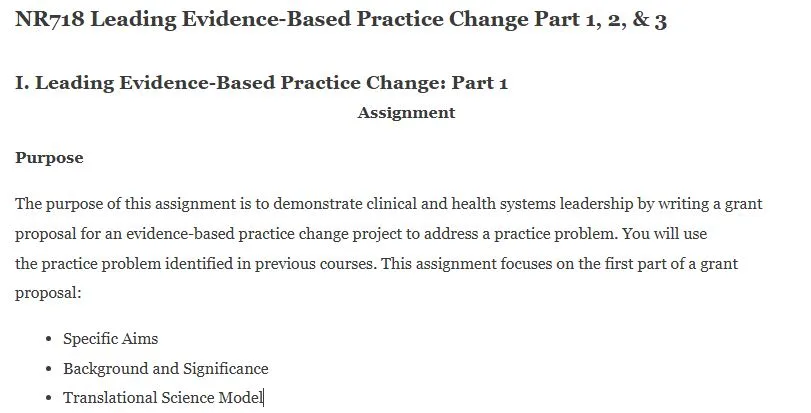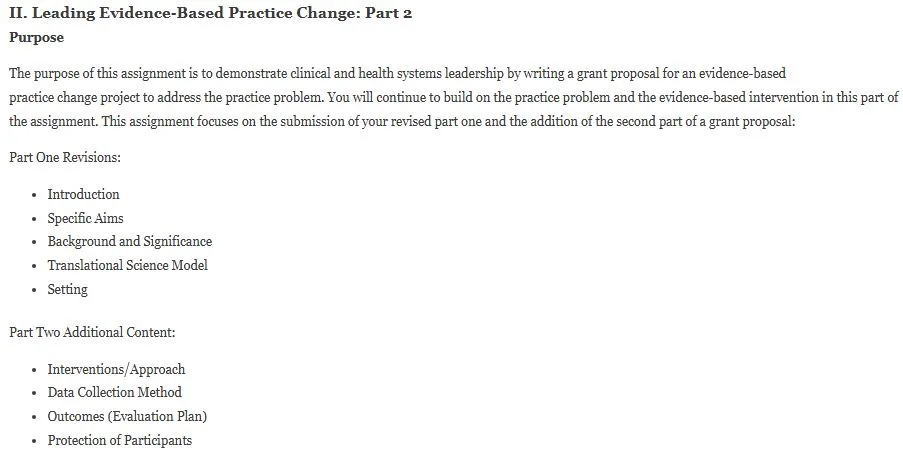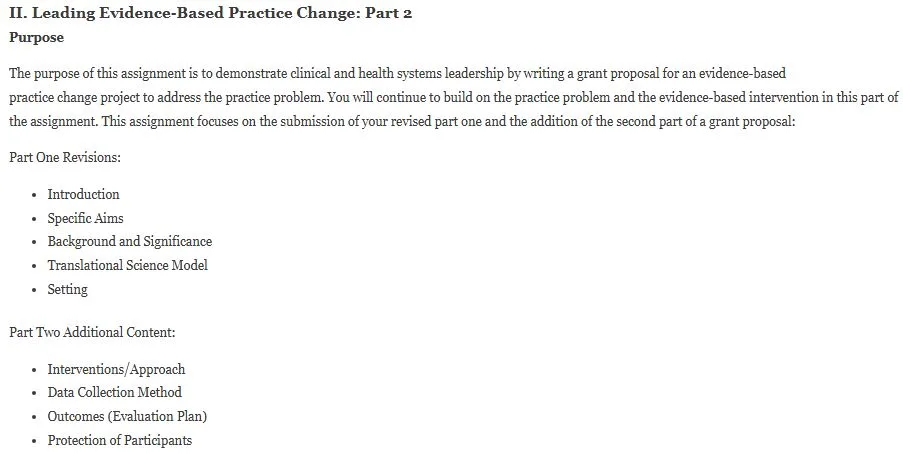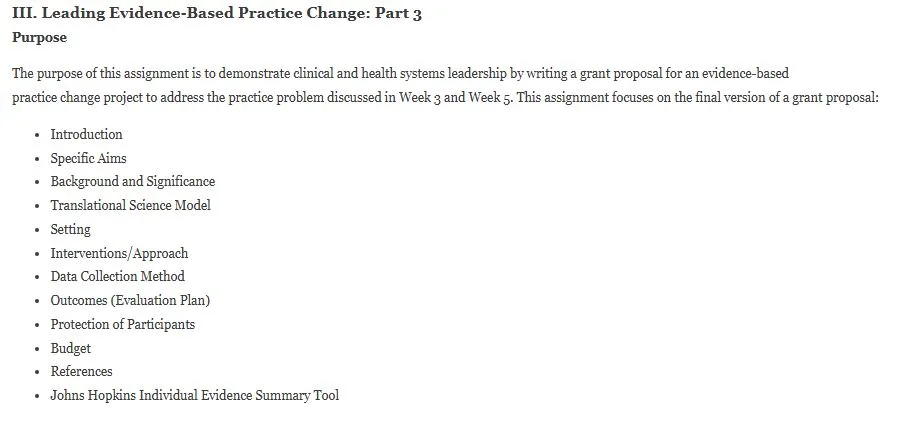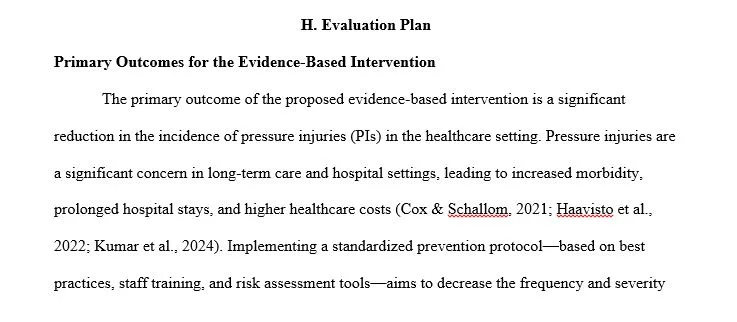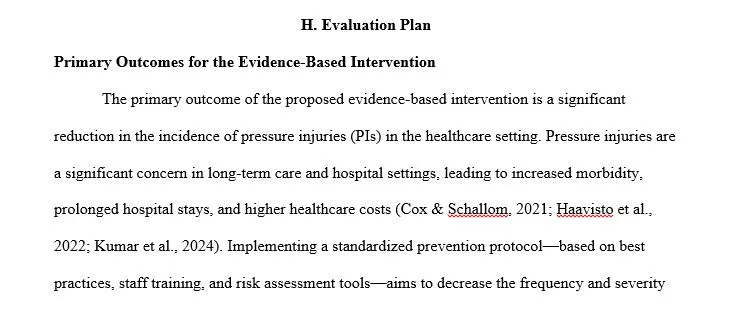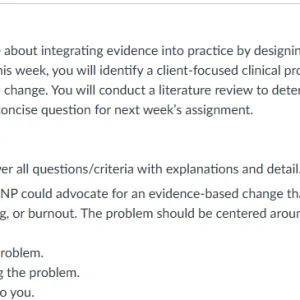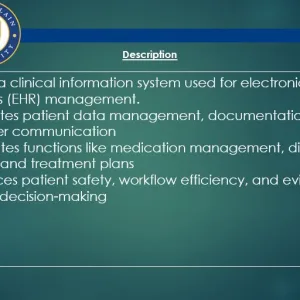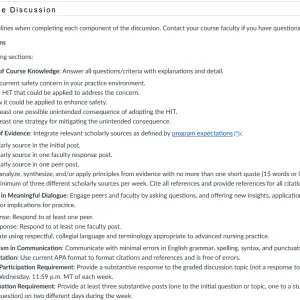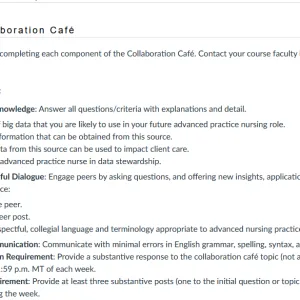NR718 Leading Evidence-Based Practice Change Part 1, 2, & 3
I. Leading Evidence-Based Practice Change: Part 1
Assignment
Purpose
The purpose of this assignment is to demonstrate clinical and health systems leadership by writing a grant proposal for an evidence–based practice change project to address a practice problem. You will use the practice problem identified in previous courses. This assignment focuses on the first part of a grant proposal:
- Specific Aims
- Background and Significance
- Translational Science Model
- Setting
Instructions
Review feedback from the discussion and write the beginning of the grant proposal that includes the following required content:
- Introduction (maximum of 1 paragraph): Provide a brief introduction that describes the following:
- Introduce the paper’s purpose and the importance of the practice change project.
- Describe intended accomplishments and long-term project goals.
- Provide a brief and defining statement of what will be discussed in the paper.
- Specific Aims (maximum of 1 paragraph)
- Describe what is hoped to be accomplished with the project, such as increased access or quality of care, etc.
- Background and Significance (maximum of 2 pages): This section lays out the reason for the grant proposal. It should make a clear, concise, and well-supported statement of the problem. The information provided should be both factual and directly related to the problem addressed by the grant proposal. The following should be addressed in this section:
- Define the purpose for developing the grant proposal.
- Identify the problem and address why this is a problem.
- Describe the nature of the problem. Provide as much evidence as possible, including the non-research data along with the research findings. Provide a synthesis of research study evidence and non-research evidence to introduce the implications of the practice problem that include the significance, mortality, and economic ramifications of the problem.
- Describe the stakeholders, who they are, and how they will benefit from the practice change project.
- Describe the specific way the problem(s) might be solved using the grant funding.
- Translational Science Model (maximum of 1 paragraph)
- Identify and briefly describe an appropriate translational science model to guide the project implementation.
- Setting (maximum of 1 paragraph)
- Describe the setting to include the type of organization (e.g., hospital, clinic, long-term care facility, etc.).
- Describe the specific population served by the organization.
- Describe the ethnic, racial, and cultural diversity of the community.
II. Leading Evidence-Based Practice Change: Part 2
Purpose
The purpose of this assignment is to demonstrate clinical and health systems leadership by writing a grant proposal for an evidence–based practice change project to address the practice problem. You will continue to build on the practice problem and the evidence–based intervention in this part of the assignment. This assignment focuses on the submission of your revised part one and the addition of the second part of a grant proposal:
Part One Revisions:
- Introduction
- Specific Aims
- Background and Significance
- Translational Science Model
- Setting
Part Two Additional Content:
- Interventions/Approach
- Data Collection Method
- Outcomes (Evaluation Plan)
- Protection of Participants
Instructions
Continue writing the grant proposal and include the following required content:
- Introduction: Provide a brief introduction that describes the following:
- Introduce the paper’s purpose and the importance of the practice change project.
- Describe the intended accomplishments and long-term project goals.
- Provide a brief and defining statement of what will be discussed in the paper.
- Specific Aims (maximum of 1 paragraph):
- Describe what is hoped to be accomplished with the project, such as increased access or quality of care, etc.
- Background and Significance (maximum of 2 pages): This section lays out the reason for the grant proposal. It should make a clear, concise, and well-supported statement of the problem. The information provided should be both factual and directly related to the problem addressed by the grant proposal. The following should be addressed in this section:
- Define the purpose for developing the grant proposal.
- Identify the problem and address why this is a problem.
- Describe the stakeholders, who they are, and how they will benefit.
- Describe the nature of the problem (provide as much evidence as possible, including prevalence data (i.e., fall rates, infection rates).
- Describe the specific manner through which problem(s) might be solved using the grant funding.
- Translational Science Model (maximum of 1 paragraph):
- Identify and briefly describe an appropriate translational science model to guide the project implementation.
- Setting (maximum of 1 paragraph):
- Describe the setting to include the type of organization (e.g., hospital, clinic, long-term care facility, etc.).
- Describe the specific population served by the organization.
- Describe the ethnic, racial, and cultural diversity of the community.
- Interventions/Approach (maximum of 3 paragraphs):
- Provide a synthesis of evidence to support the evidence–based intervention for the selected problem. Include 3 current Level I, II, or III peer-reviewed primary research studies and/or systematic reviews.
- Synthesis of the literature
- Use a synthesis of research evidence when writing this section of the paper.
- Synthesize the main themes and salient points that emerge from a synthesis of research evidence.
- Compare and contrast the main points from a synthesis of research evidence.
- Presents an overarching synthesis of evidence about the intervention.
- Provides objective rationale for the intervention based on the literature.
- Includes a minimum of three peer-reviewed research studies that support the intervention. Enter these on the Johns Hopkins Individual Evidence Summary Tool.
- Data Collection Methods (minimum of 1 paragraph):
- Describe the method or process for data collection including how often measurements will be taken. Describe how, when, where, and who will collect the data.
- Outcomes (Evaluation Plan) (minimum of 1 paragraph):
- Explain the primary outcome for your evidence–based intervention.
- Explain how the success of the project will be evaluated when it is fully implemented. This is a discussion about the outcome and the relationship between project success and the outcome(s).
- Protection of Participants (minimum 1 paragraph):
- Examine potential HIPAA and ethical risks of your change project.
- Explain how you will mitigate these risks to protect the participants.
- References
- Johns Hopkins Individual Evidence Summary Tool
- Include 3 Level I, II, or III research articles or systematic reviews.
- Complete all sections entirely and identify the quality and levels of evidence accurately.
- Include the completed Johns Hopkins Individual Evidence Summary Tool with this assignment.
III. Leading Evidence-Based Practice Change: Part 3
Purpose
The purpose of this assignment is to demonstrate clinical and health systems leadership by writing a grant proposal for an evidence–based practice change project to address the practice problem discussed in Week 3 and Week 5. This assignment focuses on the final version of a grant proposal:
- Introduction
- Specific Aims
- Background and Significance
- Translational Science Model
- Setting
- Interventions/Approach
- Data Collection Method
- Outcomes (Evaluation Plan)
- Protection of Participants
- Budget
- References
- Johns Hopkins Individual Evidence Summary Tool
Instructions
Review faculty feedback from the Week 3 and Week 5 assignments, update the paper, and add the budget section to finalize the grant proposal. Include the following required content:
- Introduction:
- Describe the paper’s purpose and the importance of the practice change project.
- Describe the intended accomplishments and long-term project goals.
- Provide a brief and defining statement of what will be discussed in the paper.
- Specific Aims (maximum of 1 paragraph):
- Describe what is hoped to be accomplished with the project such as increased access or quality of care, etc.
- Background and Significance (maximum of 2 pages): This section lays out the reason for the proposal. It should make a clear, concise, and well supported statement of the problem. The information provided should be both factual and directly related to the problem addressed by the proposal. The following should be addressed in this section:
- Define the purpose for developing the grant proposal.
- Identify the problem and address why this is a problem.
- Describe the nature of the problem. Provide as much evidence as possible, including the non-research data along with the research findings. Provide a synthesis of research study evidence and non-research evidence to introduce the implications of the practice problem that include the significance, mortality, and economic ramifications of the problem.
- Describe the stakeholders, who they are, and how they will benefit.
- Describe the specific way the problem(s) might be solved through the grant funding.
- Translational Science Model (maximum of 1 paragraph):
- Identify and briefly describe an appropriate translational science model to guide the project implementation.
- Setting (maximum of 1 paragraph):
- Describe the setting to include the type of organization (e.g., hospital, clinic, long-term care facility, etc.).
- Describe the specific population served by the organization.
- Describe the ethnic, racial, and cultural diversity of the community.
- Interventions/Approach
- Provide a synthesis of evidence to support the evidence-based intervention for the selected problem. Include 3 current Level I, II, or III peer-reviewed primary research studies and/or systematic reviews.
- Synthesis of the literature (maximum of 3 paragraphs):
- Use a synthesis of research evidence when writing this section of the paper.
- Synthesize the main themes and salient points that emerge from a synthesis of research evidence.
- Compare and contrast the main points from a synthesis of research evidence.
- Presents an overarching synthesis of evidence about the intervention.
- Provides objective rationale for the intervention based on the literature.
- Data Collection Method (minimum of 1 paragraph):
- Describe the method or process including how often measurements will be taken. Describe how, when, where, and who will collect the data.
- Outcome (Evaluation Plan) (minimum of 1 paragraph):
- Explain the primary outcome for your evidence-based intervention.
- Explain how the success of the project will be evaluated when it is fully implemented.
- Protection of Participants (minimum of 1 paragraph):
- Examine potential HIPAA and ethical risks of your change project.
- Explain how you will mitigate these risks to protect the participants.
- Budget (maximum of 2 paragraphs):
- Explore areas where you may have expenses associated with your grant proposal (specific dollar amounts are not required).
- Justify the expenses that you will be presenting in your grant proposal.
- References
- Johns Hopkins Individual Evidence Summary Tool
- Include 3 Level I, II, or III research studies or systematic reviews.
- Complete all sections entirely and identify the quality and the levels of evidence accurately.
- Include the completed Johns Hopkins Individual Evidence Summary Tool with this assignment.
Solution for NR718 Leading Evidence-Based Practice Change
The purpose of this task is to lower the incidence of pressure wounds, foster the safety of patients, and minimize the costs of healthcare arising from prolonged stays in hospitals and complications. Even though they may be avoided, pressure-related injuries continue to occur and result in increased medical expenses, extended hospital admissions, and pain for patients…
- Specific Aims
This grant proposal aims to secure funding for an evidence-based practice change project focused on preventing pressure injuries in long-term care facilities through a structured prevention program. According to Cox & Schallom (2021) and Haavisto et al. (2022), pressure injuries are a significant healthcare concern,..
Nature of the Problem
Despite attempts, pressure injuries (PIs), or pressure ulcers, still represent a significant healthcare concern, especially in long-term care facilities where patients are immobile for the vast majority of their time and at substantially increased risk. PIs add to an increased morbidity, prolonged hospital stays, and substantial…
- Budget
The grant proposal for implementing a pressure injury prevention program will incur several key expenses for effective project execution and sustainability. Staff education and training are the primary costs, including instruction………….Purchase full paper for $50.00
Purchase Now
